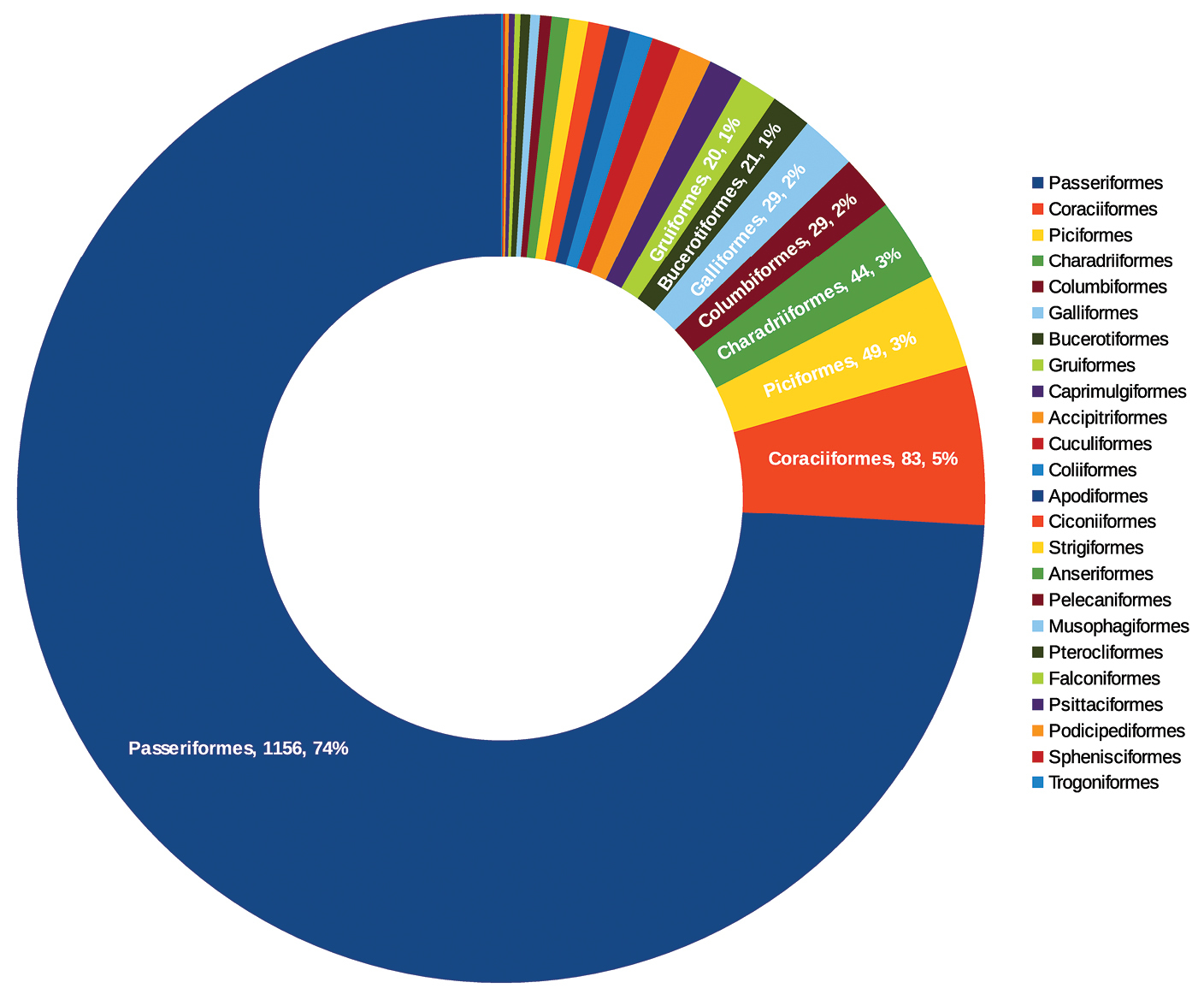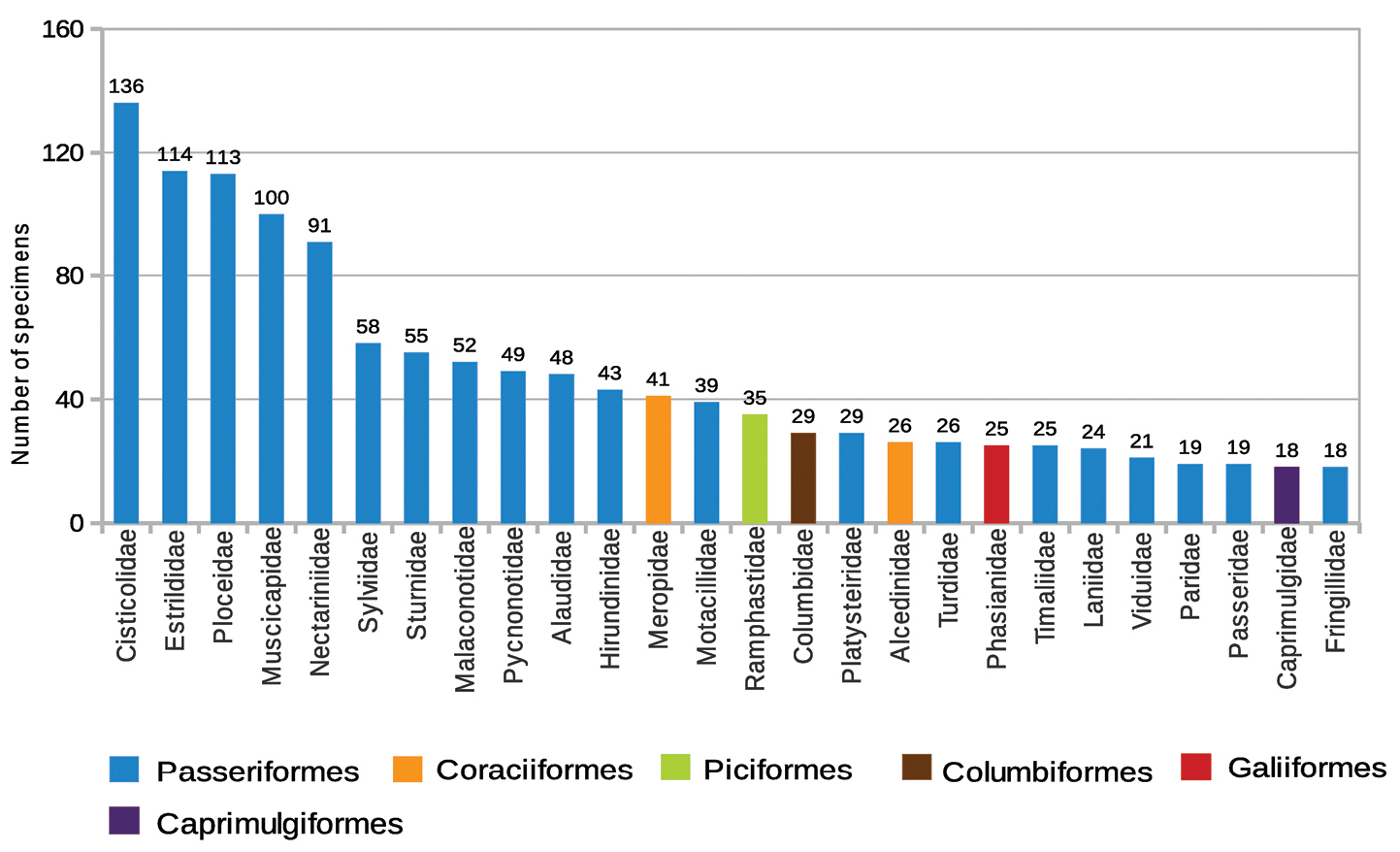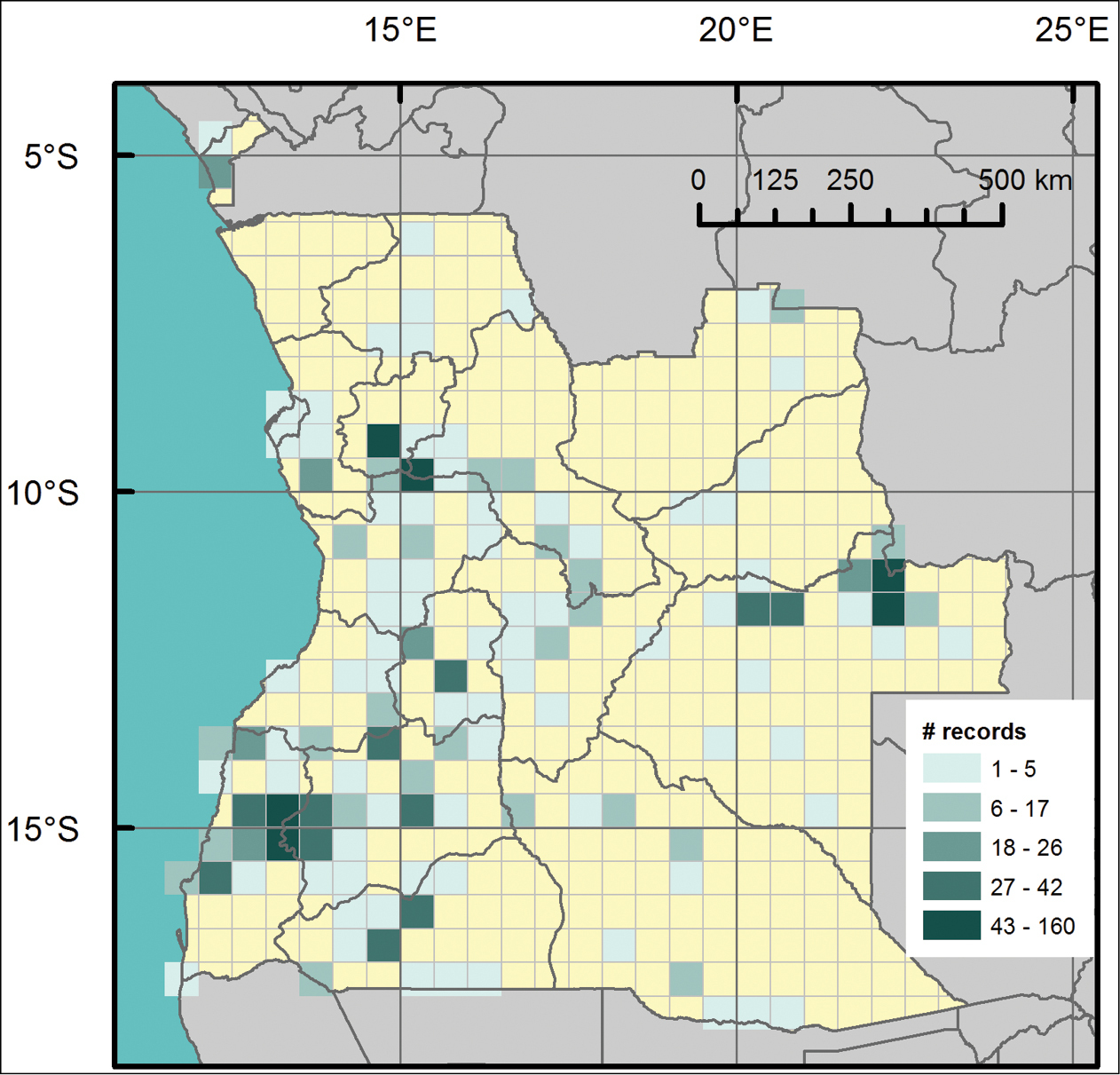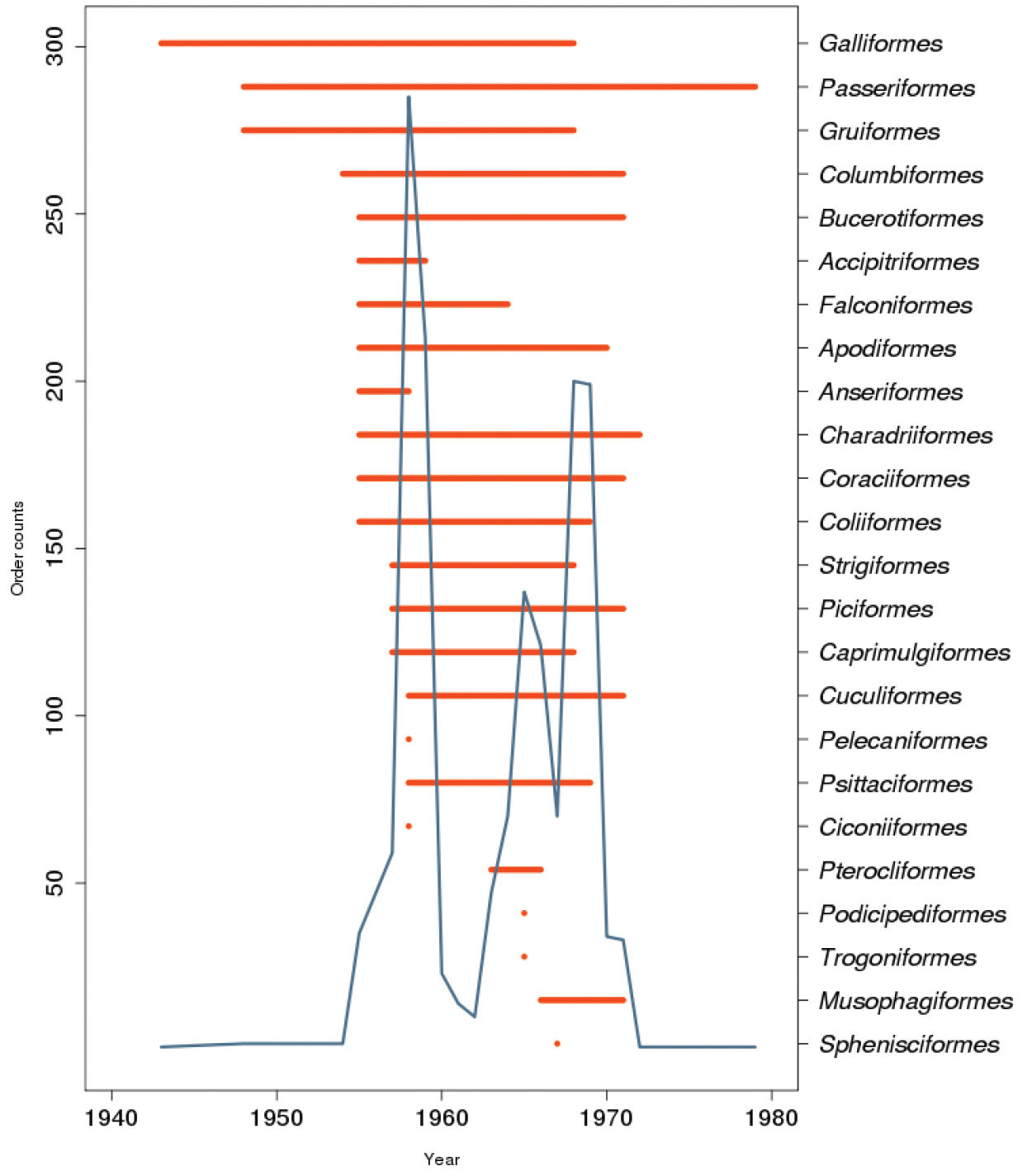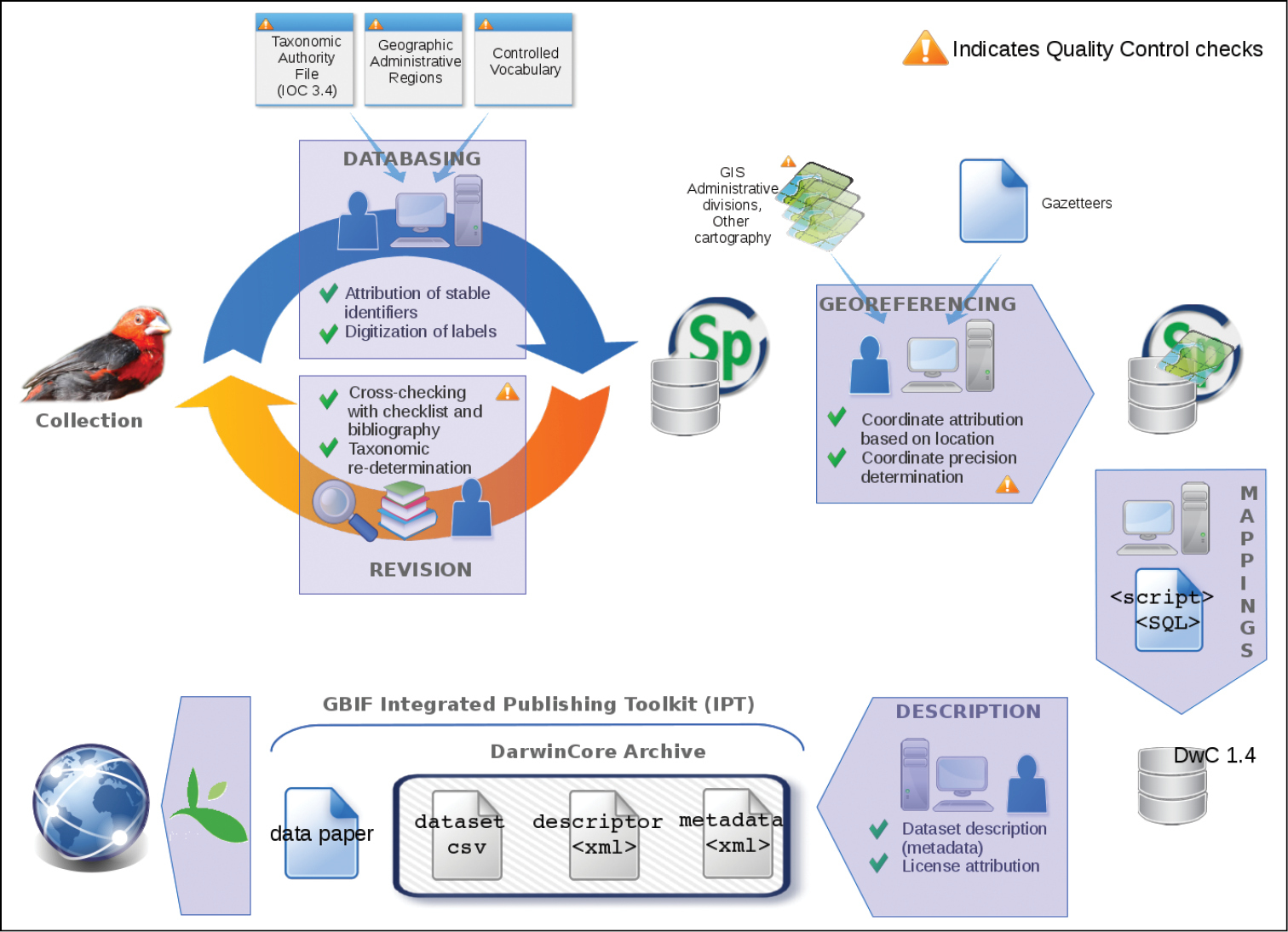






Citation: Monteiro M, Reino L, Beja P, Mills MSL, Bastos-Silveira C, Ramos M, Rodrigues D, Neves IQ, Consciência S, Figueira R (2014) The collection and database of Birds of Angola hosted at IICT (Instituto de Investigação Científica Tropical), Lisboa, Portugal. ZooKeys 387: 89–99. doi: 10.3897/zookeys.387.6412
Resource Citation: Instituto de Investigação Científica Tropical (2013) IICT Bird Collection of Angola. 1560 records, Contributed by Mumputu D, Rosa Pinto A, Carlos J, Ferreira A, Nóbrega F, Pereira A, Samahina L, Loureiro M, Simões E, Morato F, Hangula L, Pontes L, Sousa D, Gouveia M, Ramos A, Barroso J, published online, http://maerua.iict.pt/ipt/manage/resource.do?r=iict_bird_angola, released on 01 September 2013. GBIF Key of parent collection: http://gbrds.gbif.org/browse/agent?uuid=c690c2b5-8002-4d12-831c-9258dd618f78, Data Paper doi: 10.3897/zookeys.387.6412
The bird collection of the Instituto de Investigação Cientítica Tropical (Lisbon, Portugal) holds 5598 preserved specimens (skins), mainly from Angola, Mozambique, Guinea-Bissau, São Tomé and Principe, and Cape Verde. The subset collection from Angola includes 1560 specimens, which were taxonomically revised and georeferenced for the publication of this data paper. The collection contains a total of 522 taxa, including 161 species and 361 subspecies. Two species are classified by the IUCN Red List as Endangered - the wattled crane (Grus carunculata) and the Gabela bush-shrike (Laniarius amboimensis) - and two are classified as vulnerable - African penguin (Spheniscus demersus) and the white-headed vulture (Trigonoceps occipitalis). The temporal span of the database ranges between 1943 and 1979, but 32% are from years 1958–1959, and 25% from years 1968–1969. The spatial coverage of the collection is uneven, with 2/3 of the records representing only four of the eighteen provinces of the country, namely Huíla, Moxico, Namibe and Cuanza Sul. It adds, however, valuable information for the Huíla area of the Angolan Scarp, which is probably a biodiversity hotspot of global conservation priority. Furthermore, this georeferenced database adds invaluable bird information to the GBIF network, for one of the countries with highest but less known biodiversity in Africa.
Occurrence, Specimen, Angola, Instituto de Investigação Científica Tropical (IICT), Animalia, Chordata, Aves
Angola is one of the countries in Africa with highest bird diversity (938 native species, according to
Even today, basic information on Angolan bird species dates mostly from before the national independence in 1974 (
In this paper we provide a comprehensive dataset based on the digitalization, taxonomic revision and georeferencing of the Angolan ornithological collection held by the Instituto de Investigação Científica Tropical (IICT), Lisbon. The dataset is freely available via the Internet, on the IICT IPT provider (http://maerua.iict.pt/ipt), and on the Global Biodiversity Information Facility (GBIF) data portal (http://www.gbif.org). It comprises information on 1560 specimens collected in 291 localities throughout Angola. The specimens were collected in expeditions carried out between 1949 and 1979, by 64 collectors. The collection contains some very valuable skins of endemic species, such as of the endemic Red-crested Turaco (Tauraco erythrolophus (Vieillot, 1819)) and Grey-striped Francolin (Pternistis griseostriatus (Ogilvie-Grant, 1890)). It also contains skins of species listed as conservation concern in IUCN Red List, including two endangered species (the wattled crane (Grus carunculata (Gmelin, JF, 1789)) and the Gabela bush-shrike (Laniarius amboimensis Moltoni, 1932)), of which there are few skins in other collections (
The dataset is a subset of the parent bird collection of the Instituto de Investigação Cientítica Tropical, which holds 5598 preserved specimens (skins), mainly from Angola, Mozambique, Guinea-Bissau, São Tomé and Principe, and Cape Verde, available through GBIF at http://maerua.iict.pt/ipt/resource.do?r=iict_cz. The collection scrutinized through this data paper is the subset from Angola, which includes 1560 specimens that were taxonomically revised and georeferenced. The collection shares the largest collectors (A. Rosa Pinto, D. Mumputu and J. Carlos) with the related biggest collection of birds of Angola, based on Instituto Superior de Ciências de Educação da Huíla (ISCED-Huíla), in Lubango. That institute inherited the collections of the former Instituto de Investigação Científica de Angola (IICA), including a bird collection with more than 35 thousand specimens, making it the largest in Africa. Although showing an uneven geographic distributions of samples, with 2/3 of the records concentrated in only four provinces (Huíla, Moxico, Namibe and Cuanza Sul), the collection adds, invaluable information for the Huíla’s area of the Angolan Scarp, which is probably a biodiversity hotspot of global conservation priority (
Project title: Online Catalogue of Biological Collections of IICT
Funding: This project was funded by the Fundação para a Ciência e a Tecnologia (FCT) through the project “Recovering the past, recording the present, and preparing the future of zoological collections in Portugal (ARCA)” (PTDC/BIA-QOR/71492/2006) and co-funded by CIBIO, Centro de Investigação em Biodiversidade e Recursos Genéticos / InBIO from the University of Porto.
General taxonomic coverage description: The taxonomic coverage of this dataset spans class, and it includes 24 orders and 69 families (Figure 1). Nearly two thirds of the specimens belong to the order Passeriformes. The Coraciiformes order ranks second, with 5% of the specimens. The families Cisticolidae, Estrildidae and Ploceidae have the highest number of records (136, 114 and 113 records respectively) (Figure 2). The families with fewest records are Bucorvidae, Ciconiidae, Picidae, Spheniscidae, Trogonidae, Turnicidae and Tytonidae, with one record each. The database contains 522 taxa (161 species and 361 subspecies).
Number and percentage of specimens per orders. Only the categories of orders having 20 or more specimens are labeled.
Number of specimens per family. The families pictured represent 80% of the number of specimens in the collection.
Kingdom: Animalia
Phylum: Chordata
Class: Aves
Order: Accipitriformes, Anseriformes, Apodiformes, Bucerotiformes, Caprimulgiformes, Charadriiformes, Ciconiiformes, Coliiformes, Columbiformes, Coraciiformes, Cuculiformes, Falconiformes, Galliformes, Gruiformes, Musophagiformes, Passeriformes, Pelecaniformes, Piciformes, Podicipediformes, Psittaciformes, Pterocliformes, Sphenisciformes, Strigiformes, Trogoniformes
Family: Accipitridae, Alaudidae, Alcedinidae, Anatidae, Apodidae, Ardeidae, Bucerotidae, Bucorvidae, Campephagidae, Caprimulgidae, Certhiidae, Charadriidae, Ciconiidae, Cisticolidae, Coliidae, Columbidae, Coraciidae, Cuculidae, Dicruridae, Emberizidae, Estrildidae, Eurylaimidae, Falconidae, Fringillidae, Glareolidae, Gruidae, Hirundinidae, Indicatoridae, Jacanidae, Laniidae, Laridae, Malaconotidae, Meropidae, Monarchidae, Motacillidae, Muscicapidae, Musophagidae, Nectariniidae, Numididae, Oriolidae, Otididae, Paridae, Passeridae, Phalacroracidae, Phasianidae, Phoeniculidae, Picidae, Platysteiridae, Ploceidae, Podicipedidae, Psittacidae, Pteroclidae, Pycnonotidae, Rallidae, Ramphastidae, Remizidae, Scolopacidae, Spheniscidae, Strigidae, Sturnidae, Sylviidae, Timaliidae, Trogonidae, Turdidae, Turnicidae, Tytonidae, Upupidae, Viduidae, Zosteropidae
Common names: Birds
General spatial coverage: The geographic range of the collection covers the whole Angola. Distribution of sampling locations is presented in Figure 3, including counts of records per grid cell, in a half a minute grid. The distribution among the Angolan provinces is uneven, with the following series: Huíla (320), Moxico (293), Namibe (202), Cuanza Sul (166), Cuanza Norte (107), Cunene (88), Cuando Cubango (54), Huambo (51), Malanje (51), Benguela (35), Bengo (29), Cabinda (26), Bie (21), Lunda Norte (16), Lunda Sul (9), Uige (9), Luanda (1). No records occur in the province of Zaire, in the north-west region of Angola. The province of collection is unknown for 82 specimens. The research unit in Angola where the main collectors where based was located in Huíla, which justifies the highest value found for that province.
Distribution of occurrence records with indication of number of records indicated on a half a minute grid system.
The temporal range of the records is between 1943 and 1979, (Figure 4). Two peak periods are observed, in 1958–1959, and in 1968–1968, with more than 200 samples per year.
Temporal profile of the specimens in the collection. The time range for each order is represented by the horizontal bars.
Parent collection identifier: 24798813-aaff-4292-98ef-8c9bc415ff14
Collection name: IICT - Colecção de Aves de Angola
Collection identifier: 9B48F857-91B6-4029-9AEF-A80F7852EC89
Specimen preservation method: Dried
Curatorial unit: 1560 with an uncertainty of 0 (skins)
Method step description: The general procedure for the processing of specimens databasing and georeferencing is represented in Figure 5. The mammal and bird collections of the IICT were initially catalogued under the scope of project ARCA (2008–2010), using the software Specify Workbench, and afterwards imported to software Specify version 6 (
Since at that time no taxonomic specialists were available to revise the collection, records were catalogued as they were labelled, without taxonomic revision or update of taxonomic names.
Synoptic of the procedure to digitize and publish the dataset online.
In 2012–2013, the IICT collection of Angolan birds was fully taxonomically revised. This taxonomic revision followed the IOC bird list (
Since no georeferencing information was available on specimen labels or associated documentation, geographic coordinates were determined following procedure and recommendations by
Study extent description: The study covers most of Angola, including 17 out of the 18 provinces. The best-represented provinces are Huíla, Moxico, Namibe and Cuanza Norte. Only the province of Zaire (NW Angola) is not represented in the collection. The temporal distribution is mainly concentrated in the decades of 1950s (especially in years 1958 and 1959) and 1960s, corresponding to 95% of the records.
Sampling description: More than one thousand records of this dataset resulted from expeditions and studies carried out by the former Section of Ornithology at the Instituto de Investigação Científica de Angola, coordinated by António Augusto da Rosa Pinto between 1958 and 1974. Some scientific results of these studies, for the non-passerine group were published in
Quality control description: Information from each specimen was catalogued in Specify 6, which involved two steps: i) digitalization of specimen’s records (performed by MR, DR, IQN and SC); and ii) taxonomic revision and data checking (performed by the first author). The authors LR and MM also contributed to taxonomic revision of the specimens. Scientific names were checked with a taxonomic thesaurus built from the IOC World Bird List (v 3.34) (
Object name: Darwin Core Archive The collection and database of Birds of Angola hosted at IICT (Instituto de Investigação Científica Tropical), Lisboa, Portugal
Character encoding: UTF-8
Format name: Darwin Core Archive format
Format version: 1.0
http://maerua.iict.pt/ipt/archive.do?r=iict_bird_angola
Distribution: http://maerua.iict.pt/ipt/archive.do?r=iict_bird_angola
Publication date of data: 2013-10-09
Language: Portuguese
Licenses of use: Use of the data for commercial or for-profit applications is permitted only via written permission from Instituto de Investigação Científica Tropical. Data are provided to users, but should not be passed on to third parties or redistributed. It is explicitly forbidden to incorporate these data into other databases of free or restricted access.
Metadata language: English
Date of metadata creation: 2013-08-22
Hierarchy level: Dataset
We are grateful to Prof. Maria Teresa Ferreira from the Instituto Superior de Agronomia (Universidade de Lisboa) for helping us in supporting the Master studies of Miguel Monteiro, and to Joana Figueiredo Santana (CIBIO/InBIO) for the all the assistance. Luís Reino was supported by FCT - Fundação para a Ciência e a Tecnologia, through the Post-doctoral grant SFRH/BPD/62865/2009, and Rui Figueira through Compromisso com a Ciência 2007 Programme.
